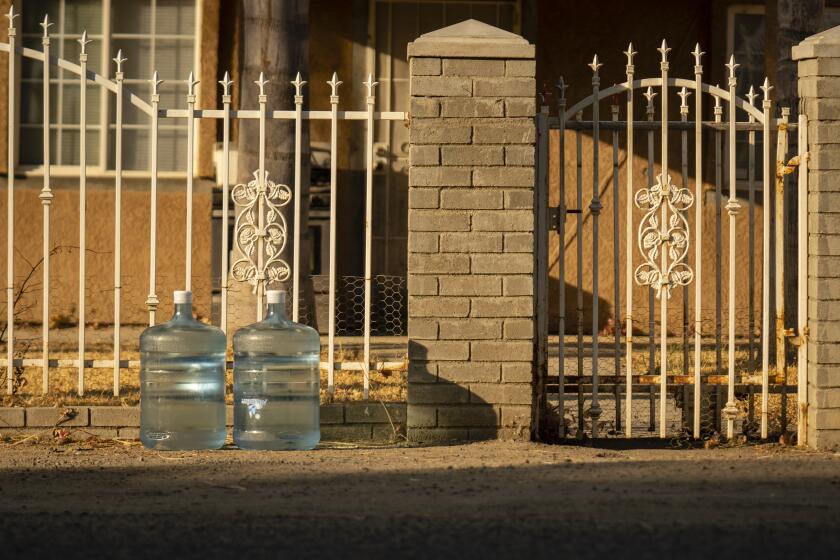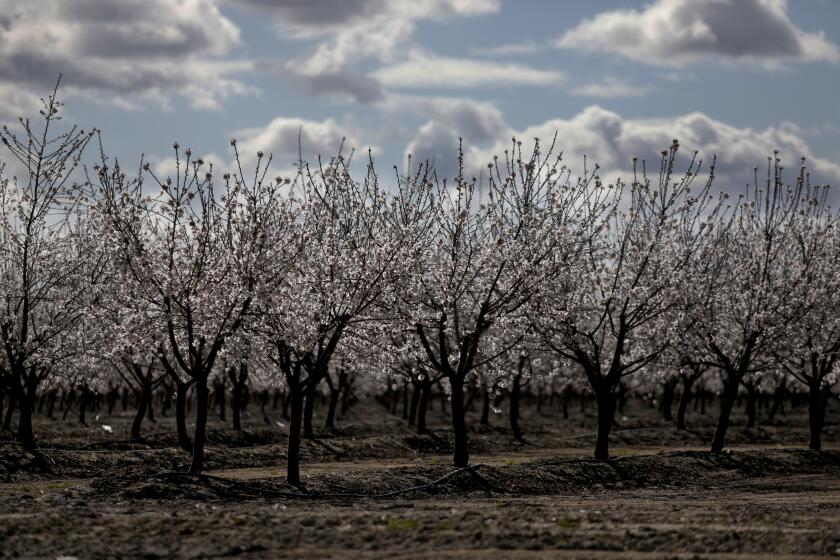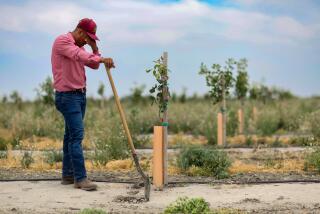
California water regulators are cracking down on a second farming area in the San Joaquin Valley for failing to take adequate steps to curb overpumping that is depleting groundwater, causing the land to sink and damaging a canal that transports water for 1 million acres of farmland and more than 250,000 people.
The California State Water Resources Control Board has voted unanimously to place the Tule groundwater subbasin on probationary status, a step that brings additional state oversight, new water fees and requirements for most well owners to report how much they are pumping.
“It just strikes me that we really are in a crisis situation,” board Vice Chair Dorene D’Adamo said after hearing hours of testimony from farmers, water managers, residents and lawyers.
State officials cited deficiencies in local groundwater management plans, including chronic declines in aquifer levels that they estimate could put more than 550 domestic wells at risk of going dry during drought.
Aggressive and impactful reporting on climate change, the environment, health and science.
They also said the plans don’t adequately limit excessive pumping that is causing the ground to sink in parts of the area. D’Adamo said the damage that rapid land subsidence is causing along parts of the Friant-Kern Canal is disturbing and needs to be addressed.
Farms in the area depend on groundwater to irrigate hay, corn, grapes, almonds, pistachios, oranges and other crops. As large amounts of groundwater are extracted, layers of sediment and clay can collapse and cause the land surface to subside.
In one area of the Tule subbasin west of Tipton, state officials said, the ground has sunk more than seven feet since 2015.
About 3.5 feet of land subsidence has been measured since 2015 along parts of the Friant-Kern Canal. The 152-mile canal, which was built by the federal government in the 1940s and early ‘50s, transports San Joaquin River water from the Friant Dam near Fresno to Bakersfield.
The Friant-Kern Canal is “experiencing alarming amounts of subsidence, causing hundreds of millions of dollars in damage,” said Jason Phillips, chief executive of the Friant Water Authority, which operates and maintains the canal. The sinking ground has significantly reduced the canal’s water-delivery capacity, and state, local and federal agencies are investing $326 million in the first phase of a project to repair a section of the canal.

Phillips supported the board’s action and specifically blamed one agency in the subbasin, the Eastern Tule Groundwater Sustainability Agency, for failing to adopt adequate plans to limit pumping and stabilize the ground. He said continuing subsidence in the area threatens to undermine recent repairs and investments, including $83 million in state taxpayer funds.
Federal officials urged the state water board to take steps to limit land subsidence and protect the canal, which is estimated to have lost more than 60% of its original capacity in its middle section.
The repair project “went through years of planning, cost hundreds of millions of dollars, and is being significantly negatively impacted due to the failure of properly managing groundwater,” said David McCray, a lawyer for the U.S. Interior Department. “Without substantive action to correct subsidence, the Friant-Kern Canal — and more than 250,000 Californians and over 1 million acres of farmland — will continue to be negatively impacted at a considerable cost.”
State officials reviewed groundwater plans prepared by seven local agencies and found that the plans failed to address the chronic lowering of groundwater levels, degradation of water quality and continuing land subsidence, among other problems. They cited estimates that current pumping in the area is depleting, on average, at least as much water each year as the combined usage of half a million homes.
Ten years ago, California adopted a law to curb chronic overpumping of groundwater. Significant challenges remain, even as the state works toward its goals.
Rogelio Caudillo, general manager of the Eastern Tule groundwater agency, urged the state board to delay putting the area on probation. He said his agency has made progress on plans to limit pumping and address land subsidence, and is taking steps to protect drinking water wells.
But board member Laurel Firestone said the agency’s pumping limits “aren’t kicking in fast enough.”
“It just seems like you need a little bit more aggressive program,” she said.
At the end of the daylong meeting Tuesday, board members voted to intervene to enforce the requirements of the Sustainable Groundwater Management Act, or SGMA. The law, which was adopted in 2014, calls for local agencies to develop plans for curbing overpumping. In many areas, agencies are required to achieve goals for managing groundwater sustainably by 2040.
The Tule subbasin is one of six areas of the San Joaquin Valley where officials have deemed local plans inadequate, and it’s the second region to be placed on probation.
After the board took its first vote to intervene in the neighboring Tulare Lake subbasin in April, farmers sued in an effort to overturn the decision, contending that the state’s demands are unreasonable and damaging to the local economy. That case in Kings County Superior Court has placed the state’s determination on hold and paused a requirement that growers begin reporting how much water they pump.
In the Tule area, advocates for protecting rural communities’ drinking water supported state intervention, warning that inaction would harm low-income people of color, including many farmworkers.
Local agencies have been slow to address problems in their plans, said Nataly Escobedo Garcia, water policy coordinator for the group Leadership Counsel for Justice and Accountability. “It continues to be frontline communities that literally pay the price and pay the cost of continued overpumping.”
Those costs, she and others said, fall on residents not only when shallow household wells run dry, but also when declining water levels worsen concentrations of contaminants, or when land subsidence damages wells.
The Tule area has an estimated population of 152,000 people and includes the city of Porterville as well as the communities of Allensworth, Alpaugh, Ducor, East Porterville and Pixley.
Some residents from Pixley told the board they are seeing worsening water quality and rising water bills, which they said are linked to declining aquifer levels.
“Our water has been getting really bad. It comes out brown. It comes out dirty. There’s no pressure,” said Christina Velasquez, a resident who said her family has been buying bottled water and no longer drinks the tap water, but still must pay higher rates.
One of the reasons for the recent increase in rates was that subsidence caused the collapse of well casing, requiring costly repairs, Escobedo Garcia said.
Beverley Whitfield said higher water bills are a financial burden, and she blamed heavy pumping by nearby dairies and other farms.
“Our wells have subsided. It’s because of overuse,” Whitfield said. “I think we deserve better.”
California water officials have estimated that the total costs of drinking water solutions for communities statewide amount to $11.5 billion over the next five years.
Recent sampling of drinking water in the Tule area has shown significant numbers of wells with contaminants such as arsenic, nitrate and the carcinogenic chemical 1,2,3-Trichloropropane at levels exceeding safe thresholds.
The law requires local agencies to avoid “significant and unreasonable degraded water quality.” The state water board’s staff listed further degradation of water quality among deficiencies in the local plans, and recommended steps to address the problems.
Managers of Tule’s local agencies recently submitted revised plans. The board’s staff said an initial review found that some issues have been addressed but that significant problems remain, especially concerning continuing land subsidence.
Now that the area is on probation, most well owners will be required within 90 days to start keeping records of how much water they pump, and will later need to report that data to the state.
Many well owners will be required to pay state fees starting in 2026, which include a flat fee of $300 per well, and $20 per acre-foot of water pumped.
The state water board determined that two local agencies, the Delano Earlimart Irrigation District and Kern-Tulare Water District, are adequately managing groundwater in their portions of the subbasin, and excluded them from fees and the required reporting of data.
The board’s staff say they will continue working with local agencies to address issues so that intervention can be ended. But if agencies fail to address deficiencies within one year, the board could pursue stepped-up intervention measures, including pumping restrictions and fines for exceeding limits.
Several farmers said they are concerned that state intervention will make their businesses even harder at a time when they are struggling with low crop prices and declining land values.
“The banks are refusing to give loans,” said Nick Sahota, a farmer in Terra Bella who said he was also speaking for other growers. “We’re losing our farms.”
A large California almond business has filed for bankruptcy. Low prices are hitting the almond industry after years of rapid growth.
Jim Morehead said he has learned to weather hard times during more than five decades in farming, but not like the challenges that are coming.
“Now, for the first time, I don’t see a future for the family farm in the San Joaquin Valley,” Morehead said. “With the implementation of SGMA, the value of my land has plummeted. Since the change in water policy five years ago, my land has dropped by 70% in value.”
He said he’s had to take one-third of his family’s farmland out of production, and expects to scale back further, which will force him to lay off employees.
“I am not against water regulation, but as I look at other states’ processes compared to California, it feels like their farmers are given much more support to succeed,” Morehead said.
Morehead’s son Justin said he fears that without local farms, their community of Pixley will struggle.
“Water is the currency of the San Joaquin Valley. The SGMA process is more than just water policy. It’s an economic framework that will determine whether rural communities will be viable long term,” Justin Morehead said.
He said the groundwater law is bringing changes “at a breakneck pace” without considering the effects on communities.
“What future is there for communities like my hometown of Pixley?” he said.











